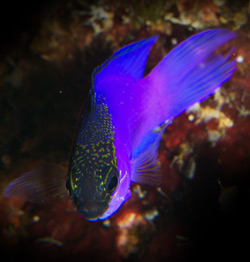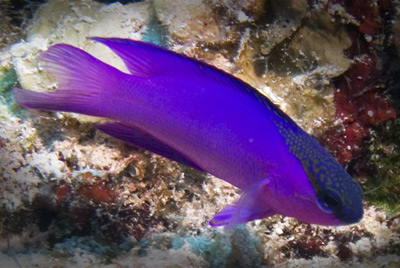Most marine aquarium hobbyists are well acquainted with the royal gramma (Gramma loreto), a worthy tank inhabitant by virtually any measure. But G. loreto isn’t the only member of the Gramma genus that is well worth its salt. Another is the blackcap basslet (Gramma melacara), a denizen of the tropical western Atlantic and Caribbean Sea that is most abundant in deeper waters.
Physical traits
G. melacara is very similar in body plan to the royal gramma, one noteworthy difference being its more deeply bifurcated caudal fin. It is purple in overall coloration with, as its common name implies, a diagonal black “cap” extending from the mouth, over the top of the head, and along the margin of the dorsal fin. Several thin white lines radiate backward from the eye. The blackcap basslet can achieve a slightly larger size than its royal cousin, with a maximum length of around 4 inches.
Feeding
This shy predator may be a bit reluctant to feed initially, but once it gets settled in and feels safe in its new surroundings, it should learn to accept various small, meaty food items, such as mysids, enriched brine shrimp, finely chopped mollusk and crustacean meat, blackworms, frozen formulas for small carnivores, and New Life Spectrum pellets.
Housing

G. melacara tends to stay in close proximity to a preferred hiding spot, so it doesn’t need a great deal of open swimming space. It does, however, require a decent amount of live rock arranged with ample caves, overhangs, ledges, and bolt holes to refuge in (which this fish will often do in an upside-down orientation). So, I wouldn’t go any smaller than a 30-gallon tank for this fish. Also, this being a deepwater species, somewhat subdued lighting is best. At the very least, be sure to provide plenty of the aforementioned rockwork ledges so your specimen can escape the glare as needed.
Compatibility
Though often shy at first, the blackcap basslet can become moderately aggressive once it gets comfortable in its new home and carves out a niche for itself. Related or similar-looking species are best avoided. This applies to conspecifics as well, though it may be possible to keep groups successfully in larger systems (hit-or-miss in my opinion). Other than that, generally peaceful species that, nonetheless, won’t be intimidated by a basslet defending its hidey hole will make suitable tankmates. Like its royal gramma cousin, the blackcap basslet makes an excellent reef aquarium candidate.



